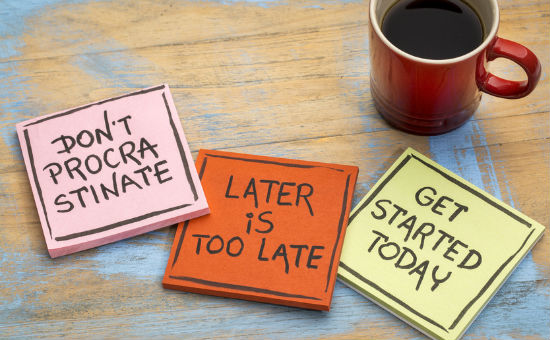It is all too much
What’s the difference between procrastinating and taking a break? A plan for what to do next. When we waste time indefinitely without any concrete plan, we create even more anxiety about what to tackle next. Once you’ve created a to do list and at least have planned to complete your tasks, you’ll feel more relaxed during your downtime and fully reap the benefits of procrastination. If the to do list with all your responsibilities paralyses you into another round of procrastination, though, write a “done” list of everything you’ve accomplished during that day or week. That will change your mind-set: You have achieved before, therefore you can do it again.
You are totally burnt out
When you’re burnt-out by work, remind yourself why you’re bothering to do the things on your to do list. Feeling stuck? Sit down every night for 15 minutes to self-reflect.
1. What did I say I was going to do today in all dimensions of my life?
2. What did I actually do today?
3. What am I proud of?
4. What am I not proud of?
5. How did I lead people?
6. How did I follow people?
7. If I lived today over again, what would I have done differently?
8. Based on what I learned today, what will I do tomorrow in all dimensions of my life?
This exercise enables you to distinguish your “must haves” from your “nice to haves”. From there, you can find priorities, delegate non-essentials to co-workers and find a more viable work-life balance.
Set a deadline
Many entrepreneurs are executing projects under self-imposed deadlines. So set a due date for your tasks – even if it’s not a real one. If you need more encouragement to push through, create a work group – on social media or in person – and organise a weekly or monthly meeting with friends and co-workers to discuss your progress on your various projects.
Procrastination is your favourite bad habit
Like any other bad habit, our procrastination follows a pattern. Though it takes between 18 and 254 days to create a lasting behavioural pattern, you can motivate yourself in time for today’s big meeting with one last tip: Watch a sports movie, suggests Fast Company. In those films, the underdog ends up winning. We can apply that same narrative to our work. After watching your favourite underdog conquer their enemy in the film, create your own imaginary scapegoat. “Think of your own insecurities and doubts and assign them to that invisible, imaginary enemy,” suggest the authors. “Are they telling you that you’re incompetent? By accomplishing your goals, you’ll prove your competence to that enemy and yourself.”
Finally, don’t procrastinate to put these tips to the test!
Read more onFastcompany

